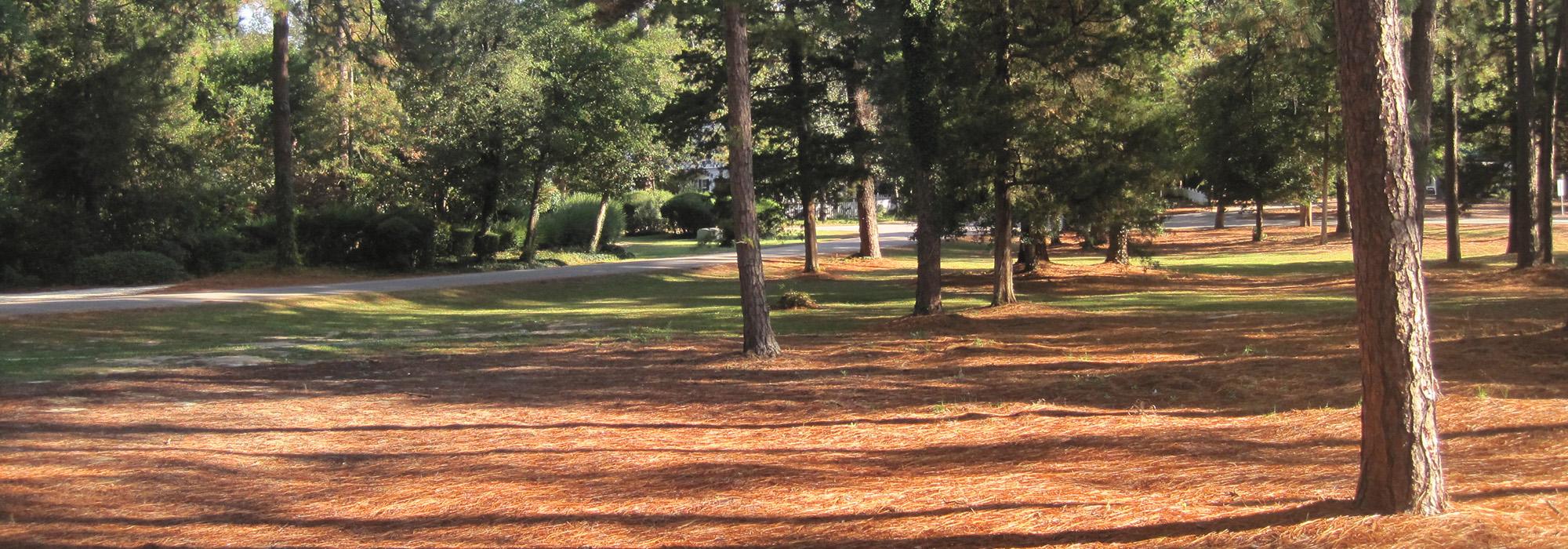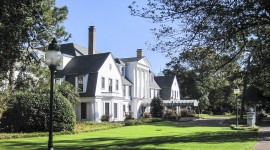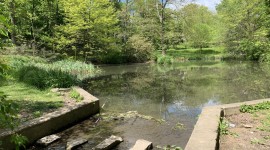Pinehurst Village: Spotlight on Olmsted and Manning’s Vision

North Carolina’s Pinehurst National Historic Landmark District, including the Frederick Law Olmsted, Sr. and Warren H. Manning landscape, are being threatened by a proposed roundabout.
Background
The Cultural Landscape Foundation (TCLF) seeks to educate and raise awareness of the irreplaceable value and legacy of the landscapes that shape the country. TCLF executes its mission of “stewardship through education” by providing outreach, developing educational tools, hosting symposia, conducting dialogue, and the like, regarding the priceless heritage of our cultural landscapes. TCLF takes a scholarly approach to its work, evoking primary historical sources to discern the design intent and historical perspective to the land designs that are works of art, texts and narratives of cultures, and expressions of regional identity. And solely from that standpoint, and with a seriousness of purpose, does TCLF conduct its activities.
The Village of Pinehurst, as a National Historic Landmark (“NHL”), holds enormous significance in the history of landscape design. As the only NHL in America, whose landscape significance is derived from the contributions of Frederick Law Olmsted, Sr. and then Warren H. Manning, Pinehurst represents an iconic example of resort and community planning. It is this nationally significant legacy that TCLF seeks to interpret, preserve and protect for future generations.
It is not the intention of TCLF to wait until controversy erupts prior to contributing its expertise relative to the history of a site, and place its significance in a greater national context. Nor is it the intention of TLCF to engage in the mechanics of local governmental or quasi-governmental bodies. Admittedly, the mission of TCLF is mighty, especially with coast-to-coast coverage demanded of a small staff. Unfortunately, the need for information and awareness-building often accompanies possibly threatening action to our irreplaceable landscape legacy.
This need for information is evident in the plan obtained from the North Carolina Department of Transportation (NCDOT). The National Historic Landmark status of the Village of Pinehurst, N.C., and the work of master landscape architects Frederick Law Olmsted, Sr., and Warren H. Manning continue to be threatened by the NCDOT and its plans to award contracts for the construction of a seventy (70’) foot diameter traffic circle. If realized, this modern intrusion alters a landscape recognized as only one of less than sixty (60) National Historic Landmarks (NHL) identified for significant works of landscape architecture – and the only such nomination where both Frederick Law Olmsted, Sr. and Warren Manning are recognized.
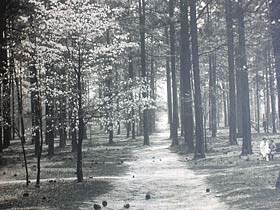
[top] This early 20th century photograph shows the Entrance to Marshall Park. [bottom] This is the current photo of Marshall Park. (Courtesy of Bettye Marcum, Pinehurst Historic Preservation Commissioner)
History
Pinehurst, North Carolina, the planned resort community established by the Tufts family of Boston in 1895, is widely recognized as sacred ground by golf enthusiasts; however, this quaint village enjoys a landscape heritage extending far beyond its sinuous green fairways. In 1895 James Walker Tufts (1835-1902) hired the firm of Olmsted, Olmsted, and Eliot, a prominent landscape architectural firm, to see his vision for a southern healthful resort take shape. The 1895 plan conceived by Frederick Law Olmsted, Sr., and carried out by Warren Manning features a curvilinear and concentric street system, producing generous amounts of green space keynoted by a village green, pine grove, and deer park (later named Marshall Park).
The collaboration of Olmsted and Manning, two towering figures in the discipline of landscape architecture, establish Pinehurst as an iconic example of resort and community planning. Furthermore, Manning’s continued involvement (with Olmsted’s blessing), as the single landscape architect for the Tufts family at Pinehurst for forty-six years, stands as a significant contribution of design influence for the profession. These significant historical developments contributed to the Village of Pinehurst’s designation as a National Historic Landmark in 1998 by the Secretary of the Interior. With approximately 2,500 properties bearing this recognition nationally, and thirty-eight (38) statewide, Pinehurst takes its place alongside other NHLs to illustrate and interpret the heritage of the United States at the highest national level. Pinehurst’s NHL recognition under criterion C for its significance as a work of a master landscape architect is a distinction shared with less than sixty (60) other NHLs, including Olmsted & Vaux’s plan for the curvilinear suburban residential village of Riverside, IL.
Pinehurst’s landscape notoriety would continue as Tufts’ resort turned from health amenities to recreation, following contemporary research on consumption. Pinehurst’s golf legacy was born and in 1900, famed golf course architect Donald James Ross took the position as head of golfing operations. Similar to Manning, Ross’s association with Pinehurst would remain until his death in 1948.
The Tufts family continued to work with both Manning and Ross to provide four-season appeal for Pinehurst. The Tufts funded additions to both the village plan and golf amenities over the years in a manner respective of the original plans and, early on, included such additions as a harness track and other recreational elements. . This legacy of landscape patronage and stewardship by the Tufts continued until the family sold the resort in 1970.
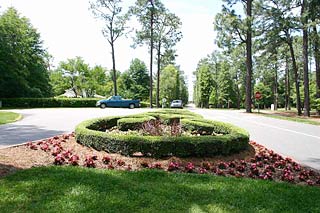
This recent view shows that the proposed roundabout would be installed where this corner feature currently sits.
(Courtesy of NCDOT Historic Architecture Group)
The Threat
Since the early spring of 2007, a debate has ensued regarding the implications of the construction of a traffic circle. Not surprisingly, much attention is given to the treatment of individual supporting elements of earlier historic plans, including both a quantity and species-by-species account of impacted vegetation. Updated plant lists obtained from the North Carolina Department of Transportation (NCDOT) identify a conscious effort to limit the loss of character defining trees affected by the proposed traffic circle. It appears NCDOT is working to limit the impact on the natural resource values (e.g. existing vegetation); however, a broader appreciation of the cultural resource (i.e. historic circulation routes) must be understood.
A closer look at the character defining landscape features of the village reveal the significant structure upon which the community lies. In his plan for the Tufts family in 1895, Olmsted introduced a system of curvilinear roads for Pinehurst in a manner and style known as the Picturesque, which he applied in 1869 his revolutionary community design with then partner, Calvert Vaux at the Village of Riverside, Illinois. As with Riverside, Olmsted’s curvilinear forms create an abundance of green space within the Pinehurst plan, while discouraging through traffic, and promote a “more leisurely and tranquil experience of the village” (USDOI, National Park Service. National Register of Historic Places. National Historic Landmark – Nomination Form, Village of Riverside, 2004). Later sympathetic additions to the plan made by Manning (a former employee in Olmsted’s office and his Superintendent of Planting) included provisions for the burgeoning resort village while adhering to the original design character and intent.
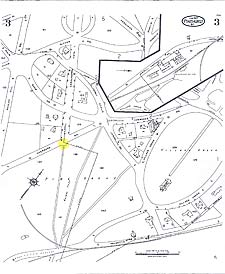
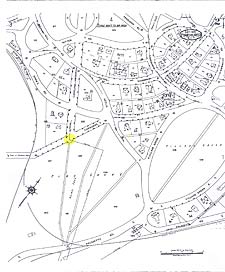
[top] Pinehurst Sanborn Map 1927-1937. [bottom] Pinehurst Sanborn Map 1920. The highlighted portion on each map shows the proposed location of the new roundabout. (Courtesy of Bettye Marcum, Pinehurst Historic Preservation Commissioner)
The original village conceived by Frederick Law Olmsted, Sr., featured concentric curvilinear streets winding through a dense village of small lots. The lots in the area which Manning began to lay out to the west of the Carolina hotel were at least double the size of the lots in the original village… (however) The curve remained a definite motif in the new plan… Warren Manning’s work demonstrates a remarkable sensitivity toward the Olmsted plan. Where lesser landscape architects might have directly challenged the by now old-fashioned curvilinear patterns of Olmsted’s…Manning, with over a decade of experience working in Pinehurst, expanded the use of the pattern and broadened its dimensions. Doing so he retained the integrity of the original village and created the architectural form of a larger resort that meshes seamlessly with its antecedent.
--USDOI, National Park Service. National Register of Historic Places. National Historic Landmark – Nomination Form, Village of Riverside, 2004.
Fitting comfortably within the period of significance of this NHL, which is 1895-1948, Manning created an additional spine road introducing Carolina Vista, connecting the hotel and the golf club, and extended the original plan westward all the while respecting the curvilinear and concentric style of the Olmsted plan.
The adverse effect of the proposed traffic circle at the intersection of Midland Road and Carolina Vista compromises the integrity of this NHL village, and could potentially jeopardize the Certified Local Government (CLG) status of Pinehurst. Hence, altering the work of a master landscape architect, recognized under Criterion C with the proposed “circular form” of a traffic circle, is incongruous with the work of Frederick Law Olmsted, Sr.’s work in the realm of community design. Olmsted introduced circular forms in the design of parks and park systems throughout his voluminous body of parks work nationwide; to suggest that a circular form is appropriate within this body of work is unfounded. The defining curvilinear and concentric form for the streets of Pinehurst, honed by Olmsted and Vaux at Riverside, is clearly a dominant theme throughout the Pinehurst plan.
The overlay of Olmsted’s evergreen landscape on the curvilinear system of village streets is a hallmark of the plan and should not be underemphasized. Manning conveys Olmsted’s intent in a letter to Leonard Tufts dated 21 April 1922, stating: “He (Olmsted) was especially pleased to learn of the prospect of securing evergreen winter effects through the use of native plants...” As in other significant projects of the firm, Olmsted saw fit to establish a nursery at Pinehurst to achieve this landscape effect, hiring Otto Katzenstein, a German nurseryman to oversee the operation. A ca.1898 plan titled, Pinehurst Golf Links, identifies a “Nursery for Plants, Trees and Shrubbery” identifies the location of one such nursery to the south of the then nine hole links, bordering the southern edge of the Deer Park. Despite the specific controversy over the number of trees to be saved or removed in the proposed plan, an understanding of Olmsted’s combination of evergreen canopy overlaid onto the curvilinear circulation system is critical, as it lends a character to the resort village not typically found in the south and represents a synergistic relationship worthy of retention.
How to Help
As noted in the Secretary of the Interior’s Standards for the Treatment of Historic Properties with Guidelines for the treatment of Cultural Landscapes, “undertaking work without understanding the significance of circulation systems is not recommended. For example, changing road alignments and widths without a thorough evaluation of the historic road” [page 68, Birnbaum, 1996]. We encourage all involved to seek more information on the character defining features of this landmark landscape, less they be compromised without due recognition to this master work. To date, TCLF’s requests to NCDOT to substantiate the technical criteria warranting the new traffic circle have not been brought forward. Interested parties may contact the NCDOT Roadside Environmental Unit, Connie Morgan (919)733-2920 to identify NCDOT’s consideration of the broader works of Olmsted and Manning described herein to include impacts to the curvilinear street system.
Despite a review of the project by the State Historic Preservation Office, identifying the traffic circle as an adverse impact to the historic district, preservation of the resource by the village has been less certain. Following a 2-1 vote (with four abstentions) by the Historic Preservation Commission (HPC), deaming the traffic circle as incongruous with this National Historic Landmark, the ruling was later thrown out as the village debated whether the traffic circle necessitated a Certificate of Appropriateness review from the HPC. The HPC is the local quasi-judicial entity responsible for reviewing projects within historic districts. Interested parties may contact the Pinehurst HPC at 910-295-2581 to identify their position on the impact this intrusion makes on the NHL as a master work of Olmsted and Manning, one of the criteria under which Pinehurst received its NHL status.
Leading the effort to preserve this landscape locally are the Concerned Citizens of Pinehurst (CCP). TCLF makes no claims, contributions or support for or against CCP, beyond recognition of their efforts to bring attention to the threat at local, state, and national levels. For more information contact “Concerned Citizens of Pinehurst”. P.O. Box 1891, Pinehurst, NC 28370 or email: concernedcitizens@nc.rr.com Tel. 910 603 2696
Throughout his forty-six year tenure on the project, Warren H. Manning “preserved the critical features of Olmsted’s vision”. As the village plans for future growth opportunities, compatible with its nationally significant heritage, it is only fitting to embrace the same stewardship fostered by Manning throughout his career for the Olmsted plan. We encourage all interested parties and those involved with the project to better understand the resource and work to preserve its integrity as a significant masterwork of landscape architecture and community design.



